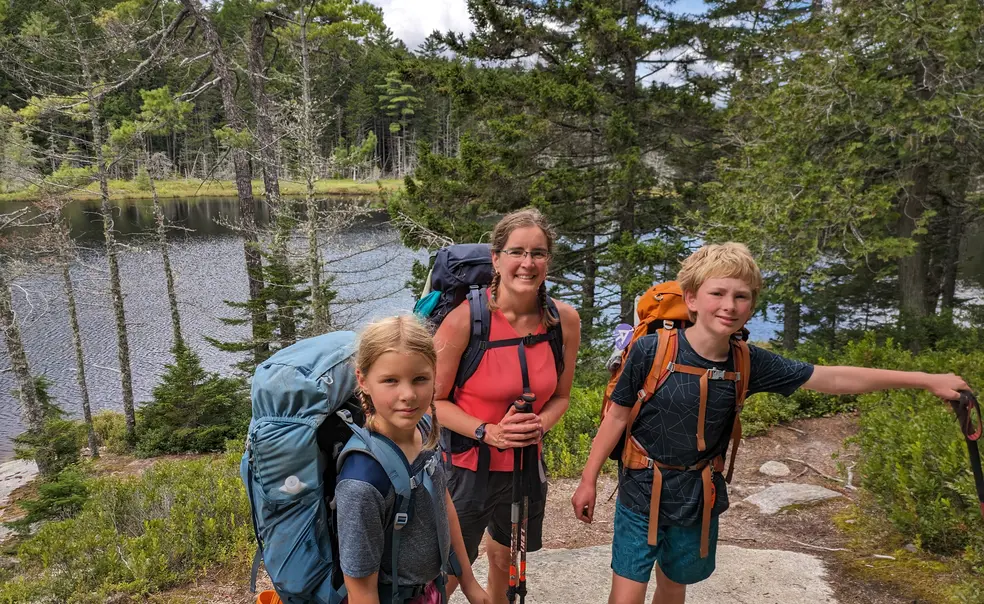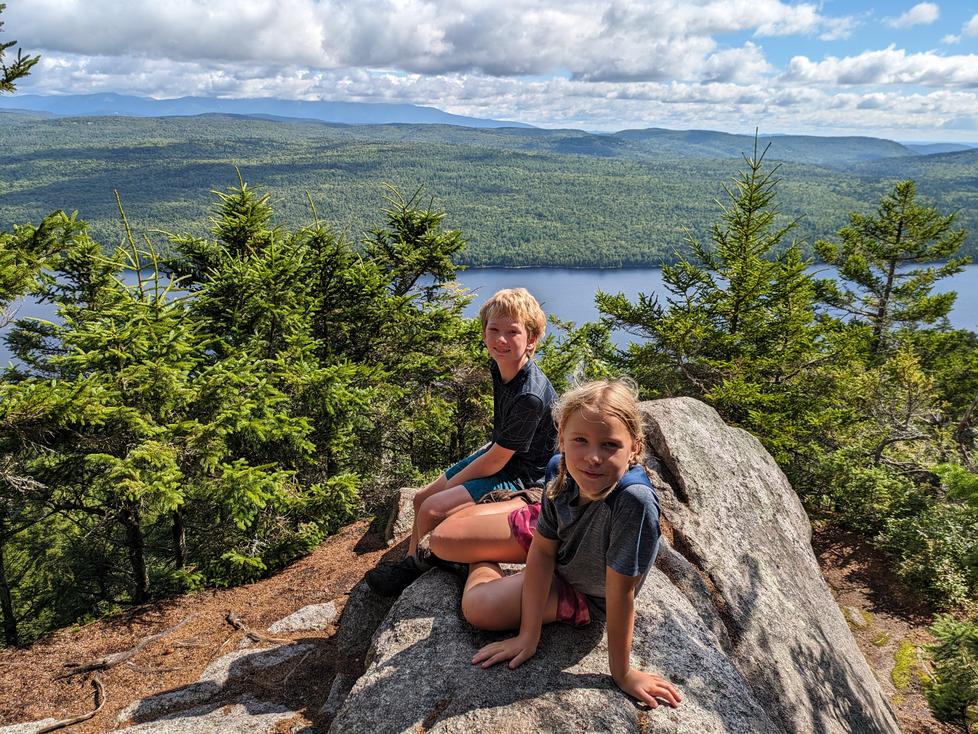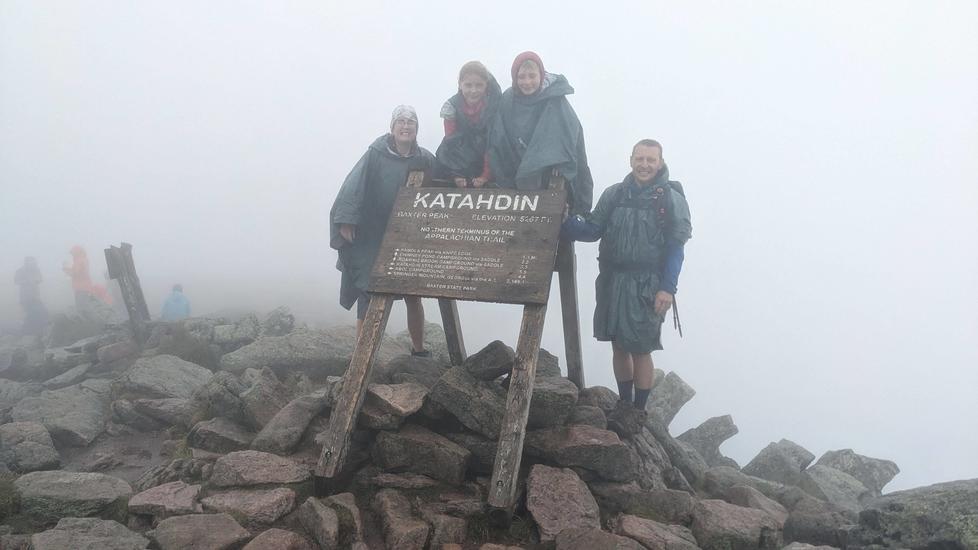This Alumna Hiked 270 Miles of the Appalachian Trail With Her Children
“I developed more patience with myself and with the kids,” said Amanda Henck Schmidt ’02
What do you talk about with your 9- and 11-year-old children while hiking more than 270 miles on the Appalachian Trail in Maine? This was among the questions I pondered while preparing for our monthlong backpacking trip this summer. In the end, it wasn’t that complicated.
“What is your dream flavor of ice cream?”
“What food would be worse if fried?”
These and other moments are what I was hoping to experience with Colby and Lua as we celebrated my recent promotion to full professor of geosciences at Oberlin College. (My husband, Josh, joined for a third of the trip.)
Backpacking has long been a major part of my life. I grew up going on annual family hikes to the White Mountains in New Hampshire, where we stayed in the Appalachian Mountain Club (AMC) huts — which serve family style meals and have communal bunk rooms. During my summers in college, I worked in the AMC huts and as a caretaker at a backcountry campsite. So naturally I introduced my children to backpacking when I realized I couldn’t afford annual trips to the AMC huts on my salary as a college professor. Colby (11) and Lua (9) had been on four backpacking trips and a series of other hiking and camping adventures before our grand hike this summer.
The idea for this hike started when I began researching where we could do a weeklong backpacking trip. Setting my sights on the Long Trail in Vermont, I started reading about families who had hiked the entire trail and thought, “Well, we could do that!” Catastrophic flooding throughout Vermont caused us to make alternate plans, so we changed course to hike a stretch of the Appalachian Trail in Maine.
We spent most of the spring preparing for the trip. We dried all kinds of food: carrot soup, lentils, applesauce, mashed sweet potatoes, and bags of frozen berries and vegetables. I agonized over where we would stay, how far we would go, and where we would get resupplies. While the kids were away at summer camp, I weighed food and packed boxes for my parents to mail us in each town. We already had most of the gear we needed, but I did spend a lot of time researching and assembling an extensive first aid kit that focused nearly entirely on blisters. Of course, this meant we had hardly any blisters, but we dealt with bad chafing from wet, dirty socks, so the first aid kit came in handy.
I was worried that I wouldn’t have anything to talk about with the kids while we were on the hike. In preparation, I scanned chapters of their history and science textbooks (they are homeschooled) so that I could find conversation topics. I agonized over what book to read aloud to them, finally settling on The Hobbit.
The reality of our hiking days became clear to me after a few days on the trail: Each day I woke up around 5:30 a.m. and the kids would wake about an hour later. We ate breakfast and drank a hot drink (tea and hot chocolate), packed up our stuff, and made it to the trail to start hiking by 8 a.m. We took regular breaks for snacks and water, and stopped hiking by 6 p.m. on most days. Then we set up the tent, made dinner, ate, and went to sleep by 8:30 p.m. I normally was able to read to them for a few minutes each night. Clearly school work of any kind was out of the question!
While we hiked, an average of 10 miles a day, the kids usually did not need to be entertained. The most common topic of conversation quickly became food, especially once hiker hunger set in. They spent a week pretending to run a restaurant and making up people’s various food orders. Sometimes they did need to be distracted, so I borrowed a joke book from the library and downloaded it to my phone to read when the kids got grouchy.
I never once opened the science or history materials I had prepared, but we talked about science a lot. Lua is really interested in ecology, and so we talked about what trees and other plants were growing along the trail, noticed when biomes changed, and looked for signs of animals. We went above treeline many times and enjoyed seeing how the ecosystem changed with the higher and more exposed areas compared to the lower and more protected areas. We also talked a lot about the geology of the mountains we were hiking through.
Colby has always been interested in ski maps and weather. On this trip he developed a fascination with maps of all kinds, and after a while he started carrying our maps and checking them regularly. Each day he conferred with me about our plan for the day, if we were going above treeline, and what mountains and rivers we would be crossing. I used this interest to make sure that both Colby and Lua became competent in reading topographic maps.
While we were hiking, I thought a lot about why people thru-hike and the optimum length for a long-distance adventure. I loved having our daily activity simply be hiking together and being outdoors. Being out on a hike for long enough that it matters if you decide to mail home the pants you never wear and are sick of carrying is pretty cool. I really enjoyed the simplicity of paring down and the evolution of the list of essentials shrinking.
The kids dictated daily journal entries that I typed into my phone, so that we have clear memories of the trip, which I think helped make each day special. I particularly reflected on this in light of some of Laura Vanderkam ’01’s writings on making memories and perception of time use. I plan to make them photo albums with their own journal entries for the text. I think for us, one month was an optimum length: Long enough to feel like we had a life on the trail but short enough to be able to preserve individual memories from every day.
I developed more patience with myself and with the kids over the trip. I had grand plans that we would all cook meals together and they would help with camp chores. In the end, I welcomed their participation as they were able, but learned to relax on the days that there was a river they just needed to play in or a rock they desperately needed to make into a pine cone race course. Colby, in particular, helped with cooking as he is working on his Boy Scouts of America (BSA) cooking merit badge. But mornings were slow for them, and I learned to be patient. It made everyone’s day go better if I just packed the backpacks while they woke up. Learning to be OK with that was a big lesson for me.
We summited Baxter Peak on Mount Katahdin in a fog bank on Aug. 17. The kids had become mountain goats over the course of the trip and easily scrambled up the trail, even though that involved a significant amount of climbing over and around massive boulders. Given the bad weather when we were there, many people turned around, but Colby and Lua confidently used their hard-won hiking skills to easily get to the summit for some foggy photos. Although I’m thrilled to be sleeping in a bed again, I also miss the easy routine of just worrying about where we are headed for the day and then walking there. The kids and I are already discussing our next long-distance hiking adventure.














No responses yet